Explainer
- Explainer
- Natural world
Clever birds and killer bots: What to know about swarm intelligence
Birds, bees and ants all co-operate to solve problems with no one in charge. Here’s what humans are learning from them.
By Angus Holland and Jackson Graham
It’s one of nature’s great spectacles. In autumn in parts of Europe, just before sunset, hundreds of thousands of common starlings (Sturnus vulgaris) congregate unbidden in vast groups and perform what appear to be aerial acrobatics, creating three-dimensional teardrops, globes, ribbons and hourglasses in the sky. In Denmark’s Wadden Sea National Park, a wetland area seasonally replete with bugs attractive to literally millions of migrating starlings, the resulting shape-shifting “clouds” are so dense the locals call them sort sol, or “black sun”.
In Rome, where starlings have gathered since ancient times (creating quite a mess), priests called augurs once made a living out of divining the will of the gods from the shapes the starlings made in the air. Similarly fascinated, British poet Samuel Taylor Coleridge described “starlings in vast flights like smoke … expanding, or contracting, thinning or condensing, now glimmering and shivering.” In 1923, famed ornithologist Edmund Selous wrote how each individual bird seemed to be “linked to every other by some invisible material, as are knots on the meshes of a net by the visible twine connecting them.”
In outback Australia, it’s wild budgerigars that put on a show. The nomadic bush budgies can throng in their tens of thousands over native grasses (and seeds) that flourish after rain in areas such as north-west Queensland.
Budgies and starlings are not unique in this communal activity. Honey bees, ants, termites, fish, and, yes, humans (sometimes) gather to prioritise the goals of the group against those of any particular individual, whether to find food, migrate, seek shelter or safely navigate a Grand Final crowd. The movements within these “murmurations” (the flocks are named for the sound of the birds’ collective wing-flapping) appear to be both random and yet, to our logical minds, somehow controlled by a form of central intelligence, so quickly and deftly do the individual creatures change direction.
Some have said it’s “swarm intelligence” that’s behind this invisible choreography. Swarm intelligence is now a major field of study, not just to discover exactly why and how some animals behave in this way but to apply this knowledge to fields such as computing, logistics and decision-making. It’s helping us predict, for example, the outcomes of sports events, to improve internet searches, to clean homes more efficiently and, somewhat worryingly, to increase the likelihood we will all be wiped out by AI-guided killer drones.
How does “swarm intelligence” work? Why do some creatures co-operate and others don’t? How useful is it to humans?
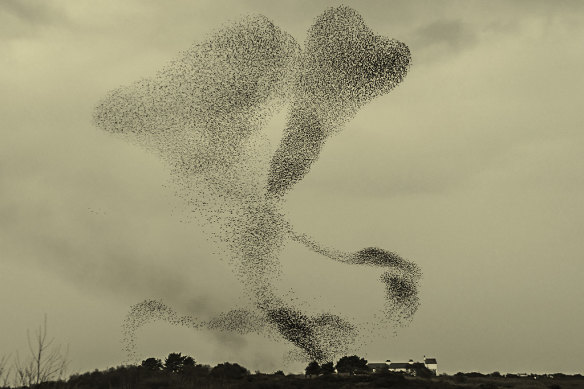
A murmuration of starlings at dusk over RSPB Minsmere Nature Reserve in Suffolk in 2018.Credit: Getty Images, digitally tinted
What’s swarm intelligence and what animals have it?
Californian electrical engineer Gerardo Beni, who, with one of his students, is credited with coining the phrase swarm intelligence, was researching robots in 1989 when his peers started bandying around words such as “group, flock, herd, horde, drove and multitude” to describe his theories. “With my Japanese colleagues, with whom I was actively involved with robotic research, we agreed to call it ‘Gunchinou’ (群知能), which suggests the idea of a swarm,” Beni tells us. “It made sense to call such groups swarms since the best examples are in the animal kingdom.”
They took inspiration from biologists studying the behaviour of ants who forage on behalf of their colony, as well as fish that cluster to diffuse attention from predators and honey bees with their “hive mind” – phenomena also known as “collective intelligence”.
‘Each knows only that it has a compulsion, or an order, to act in a certain way.’
At its most basic, collective intelligence can be seen as part of animals ensuring their survival, individually or as a colony. What’s baffling, though, is that the actions of the individuals follow similar patterns that influence the whole without any direction from a central decision-maker. “In other words,” says Beni, “nobody knows either the end nor the means whereby this goal will, or will not, be achieved. Each knows only that it has a compulsion, or an order, to act in a certain way.”
Lisa O’Bryan, whose research at Rice University in Houston, Texas, spans behavioural ecology, psychology and engineering, says not all animal group behaviours should be classified as swarm intelligence. “Simple herding behaviour is not necessarily a type of swarm intelligence,” she tells us. “It is only when these behaviours lead to the solving of explicit problems that they can be considered swarm intelligence.”
Christos Ioannou, professor of behavioural ecology at the University of Bristol, England, has another stab at a definition. “Swarm intelligence is about responding to stimuli, but the swarm intelligence is about taking the limited information of individuals about these stimuli and processing them in a decentralised way so that the group responds in a more intelligent way than if individuals responded alone.”
Whether the behaviour is strictly a form of intelligence is a matter of debate. Melbourne University evolutionary ecologist Mark Elgar, for one, is not a fan of the phrase, suggesting it implies that ants, for example, make rational, democratic choices. In reality, a lot of a colony’s apparently collective behaviour is pretty random: foragers head off and occasionally bump into food, then leave a trail when they return to the nest, which other workers then follow.
“The collective is not a physical entity that you can get your hands on. It is the interaction between the individuals in the collectives. It defines intelligence from a different perspective,” says Hussein Abbass, a swarm intelligence researcher at the University of NSW. Indeed, write Thomas Malone and Michael Bernstein in the Handbook of Collective Intelligence, “There have been almost as many definitions of collective intelligence as there have been writers who have described it.” Their take: “Groups of individuals acting collectively in ways that seem intelligent.”
The phenomenon shows up differently in different types of animals and within species, depending on their individual goals and how closely related they are to the other members of the group. Thousands of types of fish, for example, swim in schools at some point in their lives. Some swim in groups of just three and others – mostly the smaller, more vulnerable ones – in populations kilometres long, the largest of which is thought to be an annual migration of billions of sardines off southern Africa.
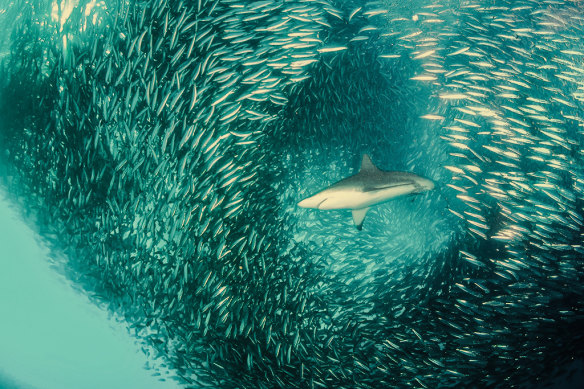
A shark swims through a ball of sardines off the east coast of South Africa.Credit: Getty Images, digitally tinted
Sardine schools can be seven kilometres long and nearly two kilometres wide. Even when there are fewer, they can form a close huddle known as a bait ball. As a predator approaches, the fish suddenly dart from the centre of the ball, causing “the confusion effect”, a split second where predators are overwhelmed. “That gives fish a bit of an edge, a bit more time to seek shelter,” says Damien Farine, a behavioural and movement ecologist at ANU. Stragglers, however, become easy pickings. Predators affect starling murmuration too: their size and duration increase when peregrine falcons or sparrowhawks are present, British researchers found in 2017, prompting swift outward bursts or divisions into subgroups.
In Australia, starlings were introduced in the 19th century and flock in rural areas in the south-east, but it’s budgies that capture the eye of birdwatchers, says Sean Dooley from Birdlife Australia. “You’ve got the red dirt, the blue sky, the green of the growth after the rainfall, and then these big wheeling flocks of green birds belting along.” The birds are forced to congregate due to limited food sources in the outback. “They live a life of being in the crowd, and that creates a great temptation for predators,” Dooley says. “They can just adjust their flight in that instant, in that microsecond. And to us, it looks like it’s somehow synchronised, like as if it’s a super-consciousness.”
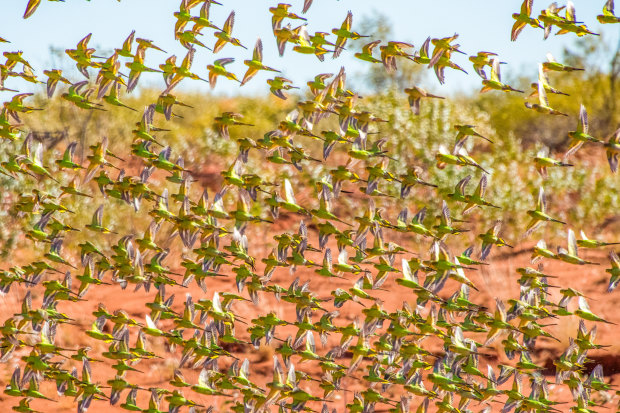
Budgerigars in the outback.Credit: Getty Images/iStockphoto
In Britain, birdwatcher Edmund Selous was convinced starlings must communicate telepathically. Unfortunately, the likely truth, as suggested by high-speed photography, is more banal: that individuals follow the movements of their near-neighbours (with an eye on each side of its head, a bird has wide-angle “binocular” vision) rather than some central, high-speed command to turn left or right.
Still, exactly why starlings murmurate before they come in to roost remains something of a mystery. Some researchers wonder whether delaying the roosting serves a purpose, such as signalling where the roost site is and possibly recruiting other birds so the site becomes warmer.
‘Half an hour after sunset, when the light has disappeared, they suddenly throw themselves down onto the chosen trees.’
“It is highly probable that their celebrated aerial choreography represents a signal, visible from a great distance, indicating the location of a suitable place to spend the night,” writes Giorgio Parisi, the Nobel-prizewinning physicist, in his book on complex systems, In a Flight of Starlings. “The first small groups to arrive from the countryside begin to dance in a way that becomes ever more frenetic as the light fades. Gradually, the latecomers join until, in the end, flocks of thousands of individuals are formed. Half an hour after sunset, when the light has disappeared, they suddenly throw themselves down onto the chosen trees.”
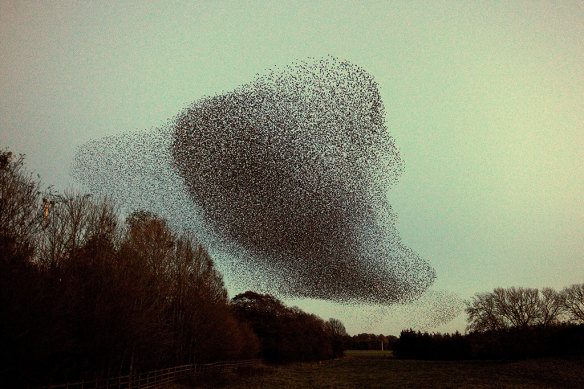
Starlings at Gretna Green in the south of Scotland in 2017.Credit: Getty Images, digitally tinted
Using high-speed photography to reveal the mysteries of murmurations in Rome, Parisi writes that he was surprised to discover that the density of birds at the edge of the flock was nearly 30 per cent greater than in the middle, “a bit like what happens on crowded buses, where frequently the crush is greatest near the doors …” He theorised this was in response to possible threats. “The birds at the margins tend to bunch up as a defence mechanism, whereas those in the centre do not need to huddle in order to feel safe: they are already protected by their fellows at the edges.”
‘Subgroups of locusts might start marching in different directions but, eventually … everyone aligns in a common direction.’
In schools of fish and flocks of birds, in a fraction of a moment, hundreds of fish or birds can move without having seen a predator themselves. “They don’t have vision beyond those eight or 10 neighbours around them,” says Farine. “These collectives are effective at producing information cascades. For example, an individual at the right-hand edge of a group spots a predator to its right, it’ll turn to the left and will precipitate a left turn by all those individuals to the left of it.” Farine stops short of calling these “rational” decisions, though. “It’s just a behavioural cue or a behaviour rule that they follow.”
The same could be said of locusts, says Camille Buhl, a senior lecturer at the University of Adelaide who researches swarming insects. A singular path emerges from myriad interactions. “This means that every day, there is usually a phase where there is a bit of disorder at first when different subgroups of locusts might start marching in different directions, but eventually, order propagates through the whole group, and everyone aligns in a common direction.”
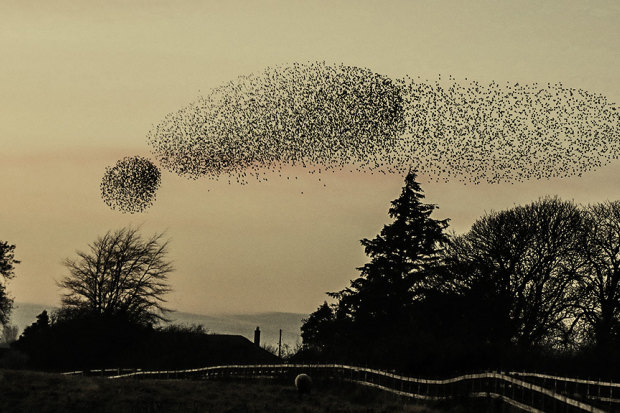
Starlings at Gretna Green in 2016.Credit: Getty Images, digitally tinted
Are some swarms smarter than others?
“The most evolved swarm intelligence is seen in social insects,” says Bristol University’s Ioannou. Many honey bees in a hive, for example, will be the offspring of one queen. “Being related means there is more likely to be a common goal for the group and less conflict within the group. Stable group membership and being able to recognise individuals within the group helps with cooperation because individuals can reciprocate a favour or avoid others who have ‘cheated’ them in the past.”
Indeed, says ANU evolutionary biologist Alexander Mikheyev, “A honeybee worker does not reproduce. Her entire life is dedicated towards the health and success of her colony. And the one who actually leaves offspring is the queen, who is typically the mother of the worker. So it’s a way of, basically, helping your relatives leave more offspring.”
When bees swarm because a colony needs to upsize its nest, some will depart in a wave, then pause while just a couple of scouts scope a new home. “They have a few days where they hang around, living on reserves that they’ve carried with them inside their bodies,” says Mikheyev. “They have to make a consensus decision for all of them to go to one place. They actually almost always pick the very best one based on a sort of criteria of what bees like.”
‘They watched ants solve the problem of finding the shortest route to the food source when presented with the choice of two possible paths, one longer than the other.’
Ants are similarly co-operative, says ecologist Mark Elgar, sometimes with extraordinary results. They recruit armies of soldiers to defend against enemies, deliberately deceive neighbouring colonies as to their true size, collect the right kinds of food for growing larvae, and use their own bodies to build bridges so others can reach food sources.
In an experiment conducted in 1989, says Beni, “They watched ants solve the problem of finding the shortest route to the food source when presented with the choice of two possible paths, one longer than the other. At first, the ants randomly choose one or the other path. But after returning a few times from the location of the food source to their ‘base camp’, they begin to all choose the shortest path.”
Among other creatures, such as fish, says Camille Buhl, it isn’t so much that individuals prioritise the group over themselves but that what’s good for the collective is good for them too. When schooling fish detect danger and begin to flee from it, certainly they are helping their comrades by signalling the threat but also gain the opportunity to get away first. Says Buhl: “Individuals who engage in collective behaviour reap some extra benefit from it without paying much of a cost.”
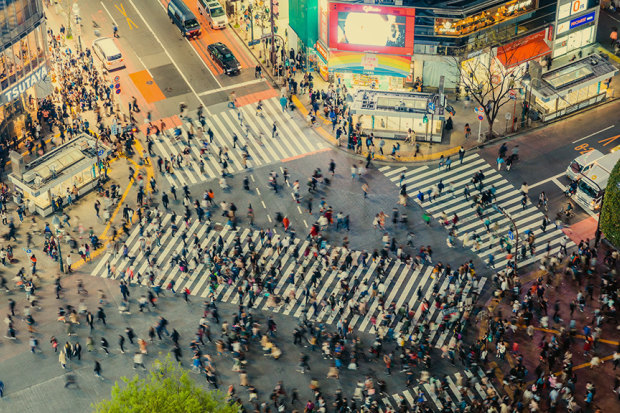
Individuals cross the road in a collective flow (kind of) in Tokyo.Credit: Getty Images, digitally tinted
Do human beings have swarm intelligence?
“For humans, many more factors enter than for animals,” Helmut Satz, physicist and author of The Rules of the Flock, tells us from Biefeld in Germany. “There are, of course, similar aspects. Let me mention just one. A swarm of fish continues to swim in a given direction, even if one or two members turn off. Only if some 10 or more turn off, the entire swarm follows. Pedestrians waiting to cross a street at a red traffic light also remain there if one or two persons start to cross against the light. But if a significant fraction of those waiting decides to cross, the whole group will follow.”
‘They try to move towards the exit, almost aligning with each other, even if they are strangers.’
Certainly, some human behaviours seem to at least mimic the swarming tendencies of animals and insects. “When you are in a crowd after you leave the stadium, for example, after a big match, the way people move, they try to avoid local collisions,” says UNSW’s Hussein Abbass. “They try to move towards the exit, almost aligning with each other, even if they are strangers to one another.”
We mostly “swarm”, too, on the road in our cars, generally co-operating, with annoying exceptions. And the rail systems of New York and Tokyo would collapse if commuters failed to at least pay lip service to respecting personal space, including by avoiding eye contact.
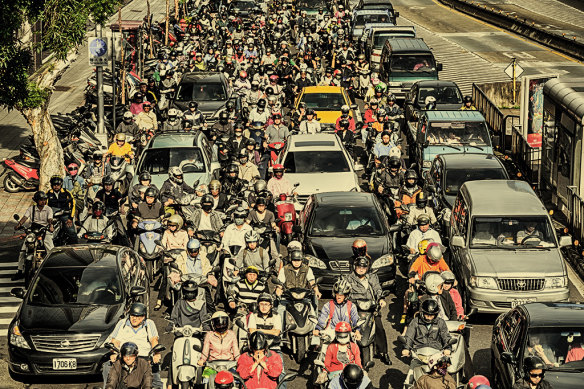
A throng of commuters pauses in Taipei. Credit: Getty Images, digitally tinted
Democracy, fundamentally, is a form of swarm intelligence in so far as it’s a system where tiny individual acts together influence the path of the whole; as is a group of friends deciding where to eat out, suggests Ioannou. “If everyone has mixed opinions about the possible restaurants, discussing it as a group can lead to a better outcome overall than if one person is left to decide.” Opinion polls and crowdsourced sites such as Reddit, Quora and Wikipedia are in a similar ballpark, possibly Google and TripAdvisor reviews too, though their efficacy can be contentious.
Flying in formation in military aircraft is not unlike the behaviour of geese migrating in a flock, maximising aerodynamic advantage (the trailing aircraft can “draft” a little off the leader to save energy) while keeping beady eyes out for predators. “When flying in cruise formation,” says the US Navy’s 2017 flight training instruction manual, “remember that all aircraft are a team … The most common error in formation operations is the lead pilot’s inability to manage more than one aircraft. All crews must think about all aircraft.”
‘From an evolutionary perspective, we are not in our comfort zone when we take to the air.’
In fact, animals are better at formation, a Royal Australian Air Force officer tells us, using sound, air pressure and other cues to determine their flight paths, unlike humans, who tend to rely on sight alone.
“From an evolutionary perspective, we are not in our comfort zone when we take to the air,” the officer, who requested their name not be shared, tells us. “It gets a little more augmented when you talk about helicopter operations, or transport aircraft – where you have people in the back, mission crew who can look out the window and they can tell the pilots what’s happening out the left-hand side, and the back.”
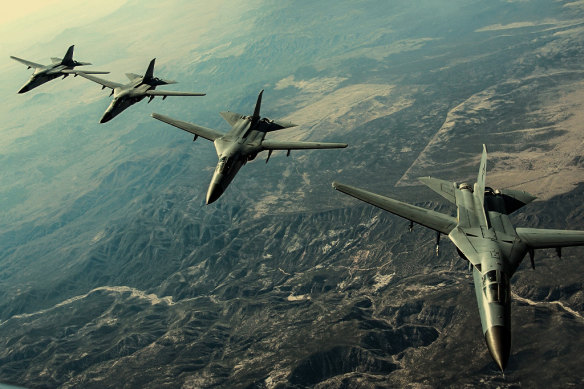
Royal Australian Air Force F-111 aircraft during exercises with the US Air Force over Nevada in 2006.Credit: Getty Images, digitally tinted
There are also situations where complete co-operation is not only desirable but essential. Elite sports teams, for example, succeed when each individual works for the overall good. The success of New Zealand’s all-conquering All Blacks rugby team has been, at least partly, attributed to a culture that prioritises the group’s welfare over that of individuals, with mantras such as “Pass the ball: leaders create leaders.”
The victory of Iceland’s men’s soccer team over a (technically) much stronger England team in the 2016 European Championships was also ascribed to a culture in which everyone’s views were respected. As Dave Robson writes in his book The Intelligence Trap, “Many commentators highlighted the down-to-earth attitude of Heimir Hallgrímsson, one of Iceland’s two coaches, who still worked part-time as a dentist. He was apparently devoted to listening and understanding others’ points of view, and he tried to cultivate that attitude in all of his players.”

Players for Iceland block a ball in their European Championships match against England in 2016.Credit: Getty Images, digitally tinted
Still, sport is something of a flawed analogy given how strongly teams, whatever their culture and motivations, rely on real-time leadership from captains and coaches, training, and strategy: no elite teams would dare to simply rely on the wisdom of the swarm.
Consider, then, the “dabbawala” food delivery service in Mumbai, India, which began in 1890 and thrives today. Often studied by Western management academics, the dabbawalas are a co-operative network of riders and sorters who each day pick up some 130,000 home-cooked meals from the suburbs in layered steel containers called tiffin boxes, or dabba, and successfully deliver them to workers downtown by lunchtime. Each dabba typically passes through six pairs of hands, on train and bicycle, with no apps, only handwritten labels and the understanding among the dabbawalas that each plays a crucial role in the overall welfare of the network.
“The dabbawalas strictly observe certain rules,” noted the Harvard Business Review in 2012. “Workers have 40 seconds to load the crates of dabbas onto a train at major stations and just 20 seconds at interim stops. The tight schedule helps synchronise everyone and imposes discipline in an environment that might otherwise be chaotic.” On the flipside, customers who are routinely tardy in preparing their dabbas for pickup are discarded as clients, as they pose a threat to the efficiency of the network.

Mumbai’s dabbawalas work together to deliver 130,000 lunches every day. Credit: Getty Images, digitally tinted
How else could swarm intelligence be used?
In his 2004 bestseller The Wisdom of Crowds, James Surowiecki argued there were many examples of how groups solved problems better than even expert individuals. This ranged from contestants on Who Wants to be a Millionaire? asking the studio audience for answers to how investors in the sharemarket react swiftly to bad news. “Collective decisions are most likely to be good ones when they’re made by people with diverse opinions reaching independent conclusions, relying primarily on their private information,” he concludes.
“Groups can solve problems that individuals within the group would not be able to solve on their own,” agrees Lisa O’Bryan. “This is because social interactions between individuals enable the processing and combination of different types of information possessed by different group members.”
In the United States, a company called Unanimous AI is attempting to harness this phenomenon for specific goals: predicting the results of sporting events or political contests and using software to help individuals discuss issues with others and, crucially, contribute their opinions or votes, without being overly influenced by others. They call it “swarming”. “Unlike votes, polls, surveys or prediction markets, which treat each participant as a passive source of data for statistical aggregation, ‘swarming’ treats each person as an active member of a real-time control system, enabling the full population to think together in synchrony and converge on optimised solutions as a unified amplified intelligence,” company chief executive and founder, computer scientist Louis Rosenberg, explained in a 2019 paper.
His company, headquartered in San Francisco, has already shown that swarm intelligence can help groups of doctors to make more accurate diagnoses and groups of financial traders to better forecast markets. “I am confident,” he tells us, “that within the next five to 10 years, we will be able to enable very large human groups to think together as a collective superintelligence that can solve problems no human could ever solve on their own.”
‘The reports that were generated were of distinctly higher quality than if you had a bunch of experts working on it.’
At the University of Melbourne, computer scientist Richard Sinnott has experimented with similar systems designed to allow groups of people to interact and come to decisions, such as on whether or not a photograph is faked, without being influenced by strong personalities or group hierarchies. In a typical military environment, for example, “you might have a commander, and nobody’s going to disagree with him, even though they know he’s wrong” (also known as HiPPO or “Highest-Paid Person’s Opinion” syndrome).
Allowing individuals to interact anonymously dispenses with social bias. “This system is really designed around an online team-based collaboration to answer questions,” he says. “We set it up in such a way that you could be quite free to chat informally with everyone else on the platform. You have no idea if you’re speaking to the director of intelligence or if you’re chatting with a cleaner. Teams rate each other’s answers to a given question that has been posed and then collectively work on the answer that was rated most highly to provide the best possible solution, leveraging everyone’s inputs. The reports that were generated were of distinctly higher quality than if you had a bunch of experts working on it.”
The other major application for swarm intelligence allows machines to be less dependent on us, their masters. Think of self-driving cars that interact with other cars to safely choose the quickest routes, groups of robots that clean large homes and commercial spaces, or communications networks that behave like ant colonies, leaving trails of electronic “pheromones” that evaporate over time.
Then there are the military applications. “Swarming drones are a big trend for the future,” says Malcolm Davis, a senior analyst at the Australian Strategic Policy Institute. “What we should expect to see in coming wars is our legacy military systems, our tanks, our fighter aircraft, our ships and so forth, being confronted with large swarms of drones which could potentially be operating independently of human control because they’re operating under artificial intelligence.”
The algorithms underlying the interactions between swarm robots and drone swarms are “frequently inspired by how groups of animals, such as birds and fish, navigate and share information about their environment,” says O’Bryan. China Electronics Technology Group broke the world record for the world’s largest-ever swarm way back in 2017, with 119 drones costing just a few hundred dollars each. “This goes all the way back to the tactics of Attila the Hun,” Randall Steeb, senior engineer at the Rand Corporation in the US, told the Financial Times. “A light attack force that can defeat more powerful and sophisticated opponents. They come out of nowhere, attack from all sides and then disappear, over and over.”
Last year, the Pentagon revealed plans to buy thousands of unmanned drones and other autonomous devices over the next two years in what it called its “Replicator” initiative. According to The New York Times, that might include “flocks” of flying, bomb-equipped drones that can loiter until they acquire a target while sharing information with other drones. The Pentagon described the technology as “small, smart, cheap” and a possible hedge against possible conflict with China. “Replicator is meant to help us overcome the PRC’s biggest advantage, which is mass. More ships. More missiles. More people,” said the US Deputy Secretary of Defence, Kathleen Hicks.
Gerardo Beni, the electrical engineer who coined swarm intelligence, or SI, agrees. “The greatest potential, in my opinion, is in the defence area. SI does not require highly trained, highly competent agents,” he says. “All they have to do is to follow a basic algorithm. The swarm can more easily escape enemy detection, no one knows the overall strategy and objective, it is not vulnerable to the loss of the leader, and its units are not ‘unique’ and can be replaced when some are lost.” For the RAAF member we spoke to, swarm intelligence isn’t something to be afraid of – yet.“I’m very happy that even very expensive robots can be in a war zone instead of people,” the officer says. “I am not fearful for my generation or the next generation. But I don’t know what it looks like when we get to full autonomy.”
Get fascinating insights and explanations on the world’s most perplexing topics. Sign up for our weekly Explainer newsletter.
Let us explain
If you'd like some expert background on an issue or a news event, drop us a line at explainers@smh.com.au or explainers@theage.com.au. Read more explainers here.